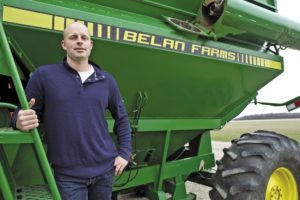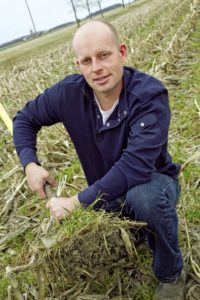Some 25 years ago, Mike Belan decided to cut costs on his farm by moving to no till. As he went along, however, the Lambton County grower determined he needed to accelerate the building of soil organic matter, so he opted for the organic practice of cover cropping.
What started out as an economic strategy turned into an environmental one — trying to better the soil’s characteristics.
“Indirectly, our goal will be for financial gain, producing a higher yield with fewer inputs and less environmental instability as we progress and build our soils,” says Belan, who favours the concept of working more with Mother Nature.
“It pertains to using organic practices with conventional farming so that we can limit our need of herbicides for weeds and chemicals for crop protection from pests. It’s also to have the ability to control and limit the need for synthetic fertilizers by working the soil biology and building our soil organic matter to efficiently and effectively use, maintain and keep our applied fertilizers for our cash crops.”
Belan’s ideal practice is to plant a cover crop that will stay green during the winter months and easily terminate to leave the soil covered with a thick mat of residue, so the only thing capable of coming up through it will be the cash crop that’s seeded into that residue.
This not only protects the soil from the harsh environments but limits the need for pre-plant burndown treatments and in-crop applications if the residue keeps weeds at bay until the crop leaves canopy and shades out the weeds. It’s also ideal if the cover crop takes a secondary role, that of a companion crop that provides a nitrogen boost.
Asked about the percentage of growers who are using a form of organic farming in their operations, Belan believes the frequency is rather low. In fact, he sees a pendulum swing in his region towards increasing tillage and plowing, particularly cultivating between soybean harvest and winter wheat planting, a practice he just doesn’t understand.
“Bottom line, these organic practices are, in my opinion, relevant and necessary in every type of farming practice, especially with row-crop growers,” says Belan. He adds that at the very least, there’s no reason for not using cover crops. “We are depleting the soil organic matter and growing less and less diversity all the time, and many growers don’t even realize it’s happening.”
There are many objections levelled by conventional growers towards organic practices, which Belan has a hard time acknowledging. One of the more common myths Belan encounters is that use of a cover crop will help the development of weed pressure — or continued growth of the cover crop — that will hinder the cash crop’s growth. Or there’s the concern that a cover crop that has overwintered too well will cause planting issues in the spring. It means it will take another level of management to deal with these issues.
Organic still bears a stigma, notes Belan, and that comes from the years of conventional agriculture, with its emphasis on high-priced equipment, clean fields and high yields.
In his eyes, however, a strong return on investment is better than high yields, especially if a grower has to “buy” those yields.
With the use of cover crops, Belan believes there is a definite swing in the way farmers are farming, and in his view, cover cropping and the reintroduction of grazing those cover crops is a unique hybrid of the organic/conventional row-cropping methods of farming.
The bottom line is that growers need to shift their approaches, if not their mindset when considering changing practices on their farms.
Nothing happens overnight, says Belan, echoing Hunter and Kerr. And that may be the hardest concept to grasp, especially in a day and age where most growers forget the lessons learned two, three or five years ago.
“A farmer definitely needs to take it slow so as not become overwhelmed with it, especially with incorporating cover crops on their farm,” says Belan, suggesting a grower try cover crops on a piece of his best land and a piece from his worst.
Put the test area right in the middle of the farm so you can compare the two, he recommends. “And stick with simple cover crop mixes to begin with. That way you can still maintain control of it in the spring before you plant your cash crop. And don’t expect large returns right away, but over the long term.”
From: Country Guide


